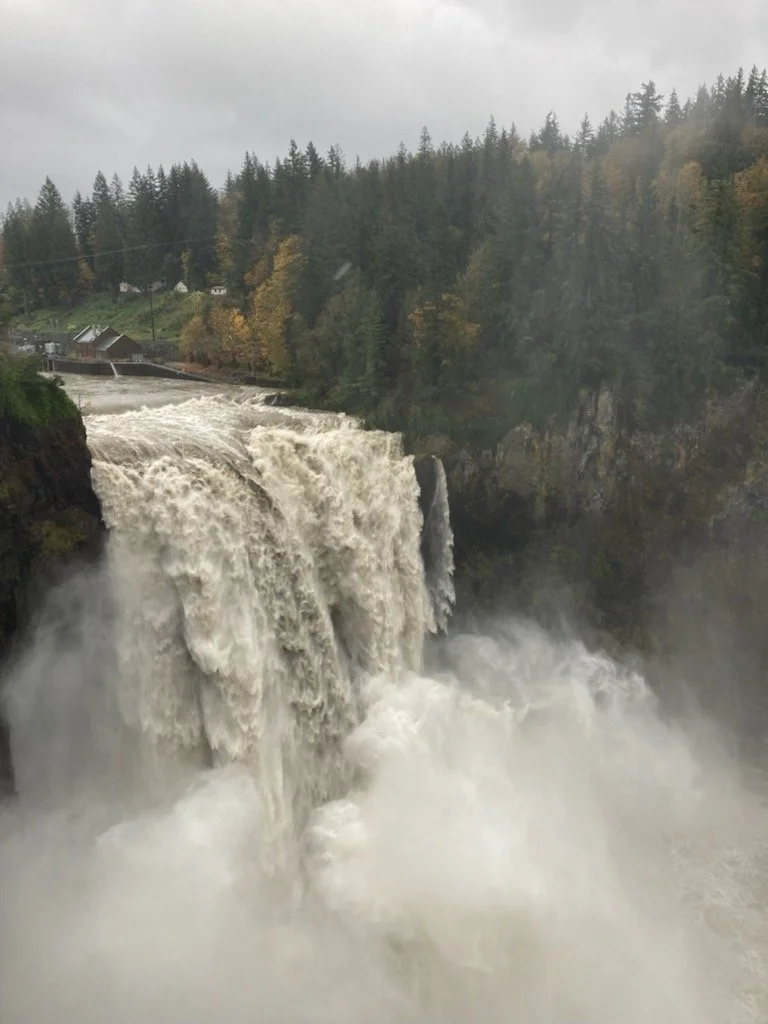Helicopter Havoc
Helicopter tourism over Snoqualmie Falls is disturbing the Snoqualmie Tribe's traditional practices. There's no legislation in place to protect them and many tour companies refuse to change their ways.
Story by Peri Croan
December 7, 2022
Each second, tens of thousands of cubic feet of water pour over the granite of Snoqualmie Falls, a waterfall around half the size, and about 40 miles east, of the Seattle Space Needle. Roaring water crashes onto slippery rocks near the bottom of the falls and into the pool below, sending up splashes of cool mist.
The Snoqualmie Falls are swollen with water from recent heavy rainfall. A cloud of mist floats up, caused by the pressure of the water hitting the pool below. Photo courtesy of Liv Larson.
These falls are not only a popular tourist destination, but the center of the Snoqualmie Indian Tribe’s creation story. In their legends, Moon the Transformer created the falls.
“Moon the Transformer created the various people and all the rivers as they are now. He placed all of the fish in the rivers and made the wild game good to eat,” the story goes.
The Snoqualmie Falls are a place where the tribe has traditionally come for ceremony and prayer. But for the past few years, unregulated helicopter tours flying over the sacred falls have been disturbing their practices and traditions. Sometimes seeing up to 25 flights a day in the summer, the tribe considers the tours to be disrespectful and intrusive to them and the ancestors buried there.
“I tried to explain to [the tour companies] what the falls meant to us and the lands around it, and it was met with hostility,” said Christopher Castleberry, treasurer of the Snoqualmie Tribal Council. “There’s nothing we could do about it because there’s no rule in place.”
The falls is a place of reflection and connection, he said. The mist acts as a vessel for their voices and prayers to reach their ancestors.
“When I’m looking at the falls and I’m involved in the mist, I’m absolutely in the moment with my ancestors,” Castleberry said. “And being taken out of that moment, looking up and hearing a loud helicopter or a low flying plane, those things just really distract from that.”
The issue is also perpetuated by private pilots and flight schools. The tribe initially talked to the Federal Aviation Administration (FAA) about a compromise, and requested rights to the airspace over the falls. Their attempts have not been effective due to the FAA and other government entities’ lack of action. The FAA was not receptive to the tribe’s request for dialogue.
Castleberry expressed that the tribe is generally welcoming and encouraging of tourists coming to see the falls and appreciates being able to share its beauty. But the frequency of the flights and excessive noise are exacerbated by the fact that helicopters are legally allowed to fly relatively low, around 500 feet above the ground, and even lower over open water.
The growing issue of helicopter tourism isn’t just limited to Snoqualmie. Frank Liszczak is a member of the Bow Valley Helicopter Noise Alliance (HNA) in Canmore, a small mountain town in Alberta, Canada. Being surrounded by scenic peaks and in close proximity to Banff National Park, the town is facing high numbers of helicopter tours as well. He describes 2015 as being the year when the noise from the helicopters became especially disruptive, with almost 4,000 total flights in and out of the town’s heliport. It’s only gotten worse since then.
Because of legal complexities, the Bow Valley HNA has been limited in what they can do other than reporting complaints, and the government has taken little action. Liszczak said it’s everywhere in the world, and describes researching similar issues in other densely-toured areas such as Hawaii, the Grand Canyon and Nepal.
Noise generated by aircrafts has an impact on wildlife as well, according to a 2003 study. Animals often rely on their hearing for protection from predators, hunting and reproduction. Exposure to loud noise can affect these behaviors, and increase stress and fear.
The Snoqualmie Tribe is still seeking government support on this issue. The FAA said setting new flight regulations over the falls could take three to five years. These flight restrictions would be similar to those above national monuments – 2,000 feet above the ground.
In the meantime, these tours are still being conducted, and the companies in question declined to comment. The tribe has also been encouraging the public to bring awareness to this issue, by asking individuals to report the noise disruptions at their sacred site.
“I think people make assumptions that we’re unruly. We just want a conversation…” Castleberry said. “We know people want to be at the falls – it’s beautiful – but let’s figure out a way to do it that’s respectful for the ones on the ground, the ones in the air, and the ones in the mist.”
The region has grown significantly in population, and heavy amounts of recreation have changed the tribe’s lands. The Snoqualmie Tribe Ancestral Lands Movement was created to spread awareness of this issue and educate the public on how to respect and help restore sacred lands. Visitors are encouraged to pick up trash and stay on designated trails, explore the lands from a place of mindfulness rather than conquest and recognize that recreation is taking place on ancestral lands, through written acknowledgement and practice.
Peri Croan is a senior in the College of the Environment. She strives to live closely with nature.

